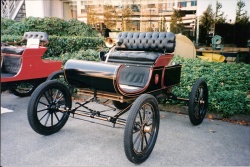 1903 Oldsmobile Curved Dash. Click image to enlarge |
Article and photo by Bill Vance
Songs inspired by cars seemed to peak in the late 1950s and early ’60s. There was “Little GTO” (for the Pontiac GTO), by Ronnie and The Daytonas (their big hit), and “Little Deuce Coupe” (1932 Ford) from the Beach Boys, who also honoured the Chevrolet 409 cubic inch engine with “409.” Such songs are far from new, however, and one of the earliest was the popular 1905 tune “In My Merry Oldsmobile,” by Gus Edwards and Vincent Bryan, dedicated to the Curved Dash Oldsmobile.
Ransom Eli Olds had built his first three-wheeled steam car in 1887, followed by another steamer in 1891. In spite of his steamer being featured in Scientific American, Olds became disenchanted with steam and produced a gasoline-powered car in 1896. It was followed by several more, and in 1897 he organized Olds Motor Vehicle Co., in Lansing, Michigan. A few electric cars were also tried.
As so often happens, Olds ran into financial difficulties and by mid-1898 had built only five or six cars. Assistance came from lumber millionaire Samuel L. Smith who wanted an enterprise for his two sons who had recently graduated from college. The company relocated to Detroit in 1899, and with the assets of the original Olds firm and the new Smith money, the company was re-established as Olds Motor Works.
Now financially sound, Olds set to work designing several new cars. There was even some concern that they had too many models but this was soon solved, although not quite as planned. In the spring of 1901, the plant was destroyed by fire, and the only thing saved was a prototype of the curved dash runabout which workers were able to push out of the burning building.
There was now no problem with too many models, and the direction of the Olds Motor Works was set. The Curved Dash, as it was named, was all they had.
The Curved Dash was a jaunty little vehicle with the dashboard curving up in front of driver and passenger in a gentle, toboggan-like arc. Its 28-inch wheels gave ample ground clearance and the 1.6-litre (94.5 cu in.) single-cylinder engine developed seven horsepower at just 500 rpm, causing wags to say it made “one chug per telegraph pole.”
The under-seat engine drove the rear wheels through a two-speed transmission and chain drive. It had tiller steering and the 318 kg (700 lb) car could reach almost 40 km/h (25 mph). It was a model of simplicity, with, for example, a longitudinal leaf spring on each side also acted as the car’s frame.
Reliability was more important than speed in those early days, and here the Oldsmobile excelled. Olds bought engines from Detroit’s renowned Leland and Falconer, America’s best engine builder.
Oldsmobile was able to rebuild the plant and assemble 425 cars in 1901. The Curved Dash was strongly promoted with advertising and public demonstrations, including several successful long-distance endurance runs capped by a 1903 San Francisco-to-New York drive in 77 days, giving sales a substantial boost.
Production rose to 2,500 in 1902, 4,000 in 1903, and 5,508 in 1904, making Oldsmobile the first quantity produced car in America.
At this point Ransom Olds and the Smiths had an irreconcilable difference. Olds wanted to continue selling light, affordable cars, particularly his beloved Curved Dash, while the Smiths preferred heavier, more expensive models. Olds lost the argument and left the company.
Several months later the indomitable Olds formed another automobile company, the R. E. Olds Company. The Smiths immediately threatened lawsuits charging infringement on their rights to his name, which Olds had sold. Olds reconsidered, concluded that he had sold his name but not his initials, and renamed his new firm the Reo Motor Car Co. It would prosper until its car business, although its not trucks, died in the Great Depression of the 1930s.
The Olds company returned to a larger plant in its old Lansing home in 1904 and produced 6,500 cars in 1905, the year Edwards and Bryan wrote their song. By 1906 the Smith’s had relegated the Curved Dash to a minor place in the line-up and Olds production fell to just 1,600 cars.
By 1907, the year Curved Dash production ceased, Olds output fell to 1,200. In 1908, production declined to 1,055 and the financially stressed company fell into the arms of Billy Durant’s newly organized General Motors Co. There it survived and thrived, becoming North America’s oldest continuous automobile manufacturer until it disappeared in 2004. Although Durant made some ill-advised purchases, Oldsmobile was not one of them.
Regardless of who owned Oldsmobile, the Curved Dash’s time had passed. It was too small and light to compete with larger cars coming on the market, especially Henry Ford’s new Model T. But it had filled an important need in the early years, become America’s first volume produced car and inspired a popular song.








